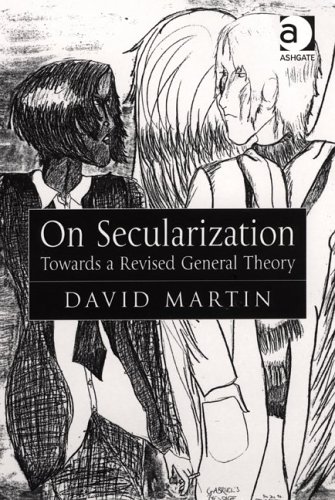On Secularization: Towards a Revised General Theory
Martin, David
Ashgate, Aldershot
2005
0754653226
 Classical secularization theories tend to view religion as inhibiting modernity (apart from the role of Protestantism in easing its early phase). Secularization and modernization are thought to go hand in hand. Classical secularization theories are therefore for the most part theories of religious decline. Its defenders typically point to historically declining rates of religious participation in Western Europe and the growth of various non-Christian beliefs (e.g., in astrology, magic and reincarnation) as evidence that religious institutions and worldviews are losing their influence. It is now generally assumed that these theories dominated the sociology of religion until the 1980s. David Martin has been one of the earliest and most trenchant critics of these classical models. His A General Theory of Secularization appeared in 1978, but that book's first chapter 'Notes Towards a General Theory of Secularization' was already published in 1969. The new book under review contributes 'Towards a Revised General Theory' – as the subtitle indicates. It is conceived as a follow-up publication and an overview of almost four decades of work. It brings together thirteen papers and conference addresses, most of which originated in the period 2002-04.
Classical secularization theories tend to view religion as inhibiting modernity (apart from the role of Protestantism in easing its early phase). Secularization and modernization are thought to go hand in hand. Classical secularization theories are therefore for the most part theories of religious decline. Its defenders typically point to historically declining rates of religious participation in Western Europe and the growth of various non-Christian beliefs (e.g., in astrology, magic and reincarnation) as evidence that religious institutions and worldviews are losing their influence. It is now generally assumed that these theories dominated the sociology of religion until the 1980s. David Martin has been one of the earliest and most trenchant critics of these classical models. His A General Theory of Secularization appeared in 1978, but that book's first chapter 'Notes Towards a General Theory of Secularization' was already published in 1969. The new book under review contributes 'Towards a Revised General Theory' – as the subtitle indicates. It is conceived as a follow-up publication and an overview of almost four decades of work. It brings together thirteen papers and conference addresses, most of which originated in the period 2002-04.
This book is a reflection on the state of religion in the modern world – although it is published as a reflection on secularization. In this regard, it illustrates once more that the theme of secularization has put religion on the agenda of sociological research again. Underlying Martin's reflections is the general observation that religious and non-religious institutions have become increasingly differentiated over time, at least in the modern West. In the general sociological literature, there exist different interpretations of the meaning and scope of social differentiation, as well as of its implications for religion. These interpretations range from classical theories of a Protestant rationalization of the world to theories, which posit that religious values have become increasingly institutionalized in secular spheres. The late work of Talcott Parsons is an example of the latter position. Martin's position in fact comes close to that of Parsons. Throughout this book, Martin explores different ways in which religious values (Christian values in particular) remain relevant and influential today despite the differentiation of society. He presents a wide range of observations on the multiple ways in which religions and modernities can go together in our world. Most attention receive issues related to nationalism and nation-building, but these issues are always discussed in the context of the current globalization processes. In this sense, there is a focus on the workings of trans-national denominations. Drawing on his previous work, Martin uses a number of illustrations related to the expansion of Evangelicalism and Pentecostalism. But it is also relevant to keep in mind that the Catholic Church has been a 'global player' by principle. After the French Revolution and the 'secularization' of society, the Catholic Church reacted in different Western European nations under the banner of ultramontanism – as Rome was situated at the other side of the Alps, ultra montes. In fact, Martin assumes that the trans-nationalism of Catholicism may achieve new relevance in the post-national phases of late modernity, leaving established Protestantism over-identified with the nation-state in its period of decline. It can be said that the alignment of religion with the national project constitutes an example of a 'displacement'. Religion is moving out of its traditional territory and into other value spheres. This book also contains a number of observations of other displacements of religion, for example into forms of art. In these value spheres, religion is able to survive and thrive – notwithstanding falling church attendance rates.
What puzzles me is that these reflections are presented as notes towards a (revised) general theory of secularization. It should be underlined that this book presents a wealth of detailed observations on religious denominations all over the globe (although some examples are repeated again and again in the different papers/chapters). But, apart from the rejection of classical theories, there is no systematic attempt to engage with other theories or interpretations of secularization. Martin heavily draws on his previous work; a very large number of references are self-citations. Other theoretical work in the sociology of religion is sometimes mentioned, but does not receive much critical attention. This is even the case for the work of authors who focus on the relationship between social differentiation and secularization, too, such as Talcott Parsons, Mark Chaves or José Casanova. Chapter 9 is from this point of view the book's most interesting chapter. I think that it is important to pay more attention to the specific impact of religion on other value spheres (political, economic, aesthetic, erotic, etc.). For a general theory of secularization, a more systematic account of the conditions and effects of different kinds of displacements of religion is still needed.
Raf Vanderstraeten
Universität Bielefeld

